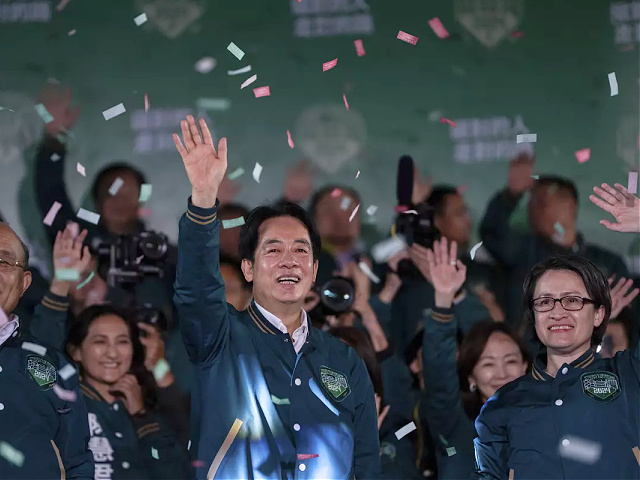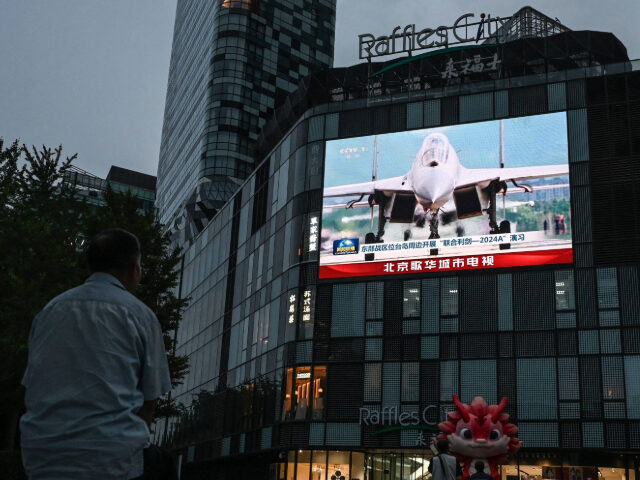The People’s Liberation Army (PLA) of China on Thursday launched two days of aggressive military drills around Taiwan, including flights by armed warplanes and simulated attacks on the island.
The PLA described the drills as “strong punishment for the separatist acts of Taiwan independence forces and a stern warning against the interference and provocation by external forces.”
This was presumably a reference to the inauguration on Monday of Taiwan’s new president, William Lai Ching-te. Lai succeeded two-term President Tsai Ing-wen, also a member of the Democratic Progressive Party (DPP) and also denounced by China as a “separatist.”
Communist China attempted to intimidate the Taiwanese out of voting for Lai, and, when that failed, it howled that his largely conciliatory inaugural speech was a “confession of Taiwan independence” by a “dangerous separatist.”
In one passage from his speech, Lai advised China to “face up to the fact that the Republic of Taiwan exists.” Many observers felt this was the line that enraged Beijing.

Taiwanese Vice President Lai Ching-te, also known as William, celebrates his presidential victory in Taipei, Taiwan, on January 13, 2024. (AP Photo/Louise Delmotte)
China’s Taiwan Affairs Office on Tuesday vowed to take “countermeasures” and “penalize the DPP authorities for colluding with external forces in their provocations for ‘independence.’”
The drills that began on Thursday were apparently part of that “penalty.” Chinese state media published a map showing that “Operation Joint Sword-2024A” would almost completely encircle Taiwan, with operations in five different nautical zones. The “A” appended to the name of the operation was clearly intended to suggest that more drills could be forthcoming.
The Taiwanese public and government did not seem terribly alarmed or intimidated by the exercise, even though it was larger than most of Beijing’s previous temper tantrums and simulated a more direct threat to Taiwan’s outlying defensive islands.
The Taiwanese Defense Ministry said 15 ships of the People’s Liberation Army Navy (PLAN) were involved in the exercise, along with 33 warplanes and 15 Chinese coast guard vessels. None of the Chinese ships or planes appeared to be conducting live-fire drills close to Taiwanese territory, and none came closer than 24 nautical miles to the coast of Taiwan’s main island.
Taiwanese officials said China’s actions were not unexpected and did not represent a dramatic escalation from the tedious “gray zone” intimidation tactics it has employed against Taiwan for the past few years.
The Taiwanese Defense Ministry nevertheless condemned China’s drills as an “irrational provocation” that demonstrated Beijing’s “militaristic mentality.”
“The launch of military exercises on this occasion not only does not contribute to the peace and stability of the Taiwan Strait,” the ministry said.
“We stand by with firm will and restraint. We seek no conflicts, but we will not shy away from one. We have the confidence to safeguard our national security,” the ministry vowed.
Taiwanese officials noted they were obliged to activate their defenses and scramble jets in case China decided to turn the drill into a real attack. This is always the case with gray zone warfare, in which the vastly larger Chinese military seeks to exhaust and demoralize Taiwan by making it respond to endless provocations.
Taiwanese military experts said the latest Chinese drill was notable for simulating a “full-scale attack” rather than an economic blockade of the island and for practicing assaults on Taiwan’s border islands of Kinmen, Matsu, Wuqiu, and Dongyin.
China’s forces also dispatched naval and air patrols to the east of Taiwan, where its most heavily fortified bases and hardened military infrastructure are located. Taiwan’s analysts deduced this was intended to show the United States and Japan that Taiwan could not be easily reinforced or resupplied from the east in the event of a full-scale Chinese attack.
Other observers speculated the PLA drills were mainly intended as a propaganda performance for internal consumption, pointing to a blizzard of social media posts, videos, and news items following Operation Joint Sword-2024A on China’s tightly controlled Internet.
Chinese state television network CCTV published posters that showed off the hardware tested in the exercise as though the planes, ships, and missiles were glamorous movie stars, billing them as “the magic weapons killing separatists.”
President Lai’s office said it was “regrettable” for China to use “unilateral military provocations to threaten Taiwan’s democracy and freedom.”
Lai himself said Taiwan stands ready to face “external threats” and “continue to defend the value of freedom and democracy and protect regional peace and stability.”
“I have confidence in the military. I also ask all my compatriots to rest assured,” Lai said while visiting a military base near Taipei on Thursday.

COMMENTS
Please let us know if you're having issues with commenting.